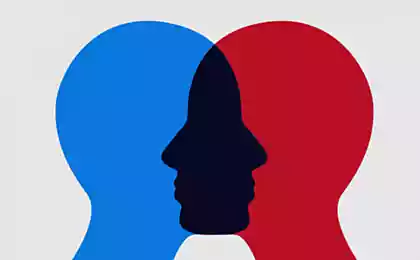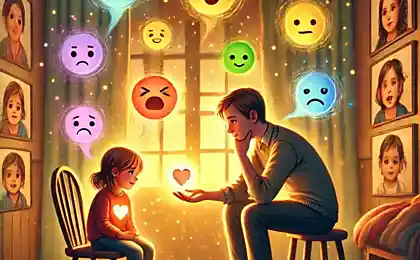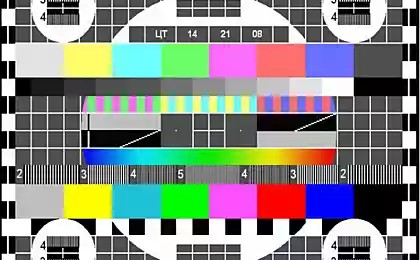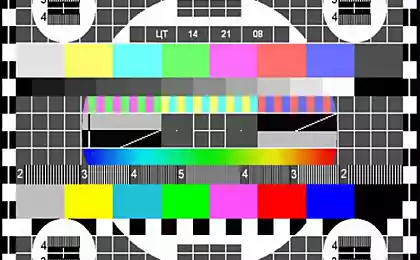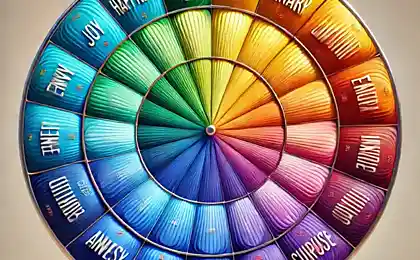1180
The feelings chart that will help you to understand yourself
I find it difficult to understand their feelings the sentence faced by each of us: in books, in movies, in life (someone else's or your own). But it is very important to be able to understand their feelings. Some believe — and they may be right that the meaning of life in the senses. In fact, at the end of life with us remain only our feelings or real memories. And measure what is happening can also be our experiences: what are they richer, more varied, brighter, the more we experience life.
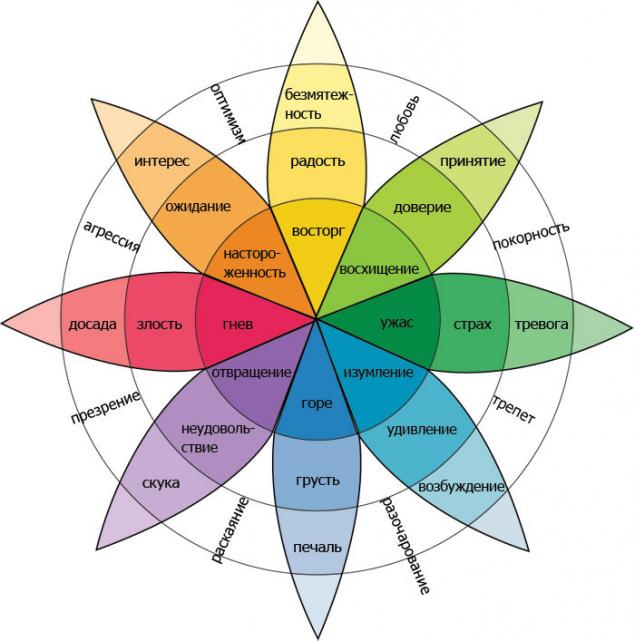
Wheel of emotions Robert Plutchik
What are the feelings? The simplest definition: feelings are what we feel. It is our attitude to certain things (objects). There is a more scientific definition: feelings (secondary emotions) — a special mental state, which manifests itself socially determined experiences that Express a long and emotional relationship of man to things.
Than feelings differ from emotions to Feelings — it is our experiences that we experience through the senses and we have five of them. Sensations are visual, auditory, tactile, gustatory and sense of smell (our sense of smell). With feelings it's simple: stimulus — receptor — feeling.
In emotions and feelings interfere with our consciousness — our thoughts, attitudes, our thinking. Emotions affect our thoughts. And conversely, emotions affect our thoughts. About these relationships, let's talk more definitely later. But now let us remember once again one of the criteria of psychological health, namely paragraph 10: we are responsible for your feelings, it depends on us what they will be. This is important.
Fundamental emotion of All human emotions can be distinguished by the quality of the experience. Most vividly this aspect of the emotional life of a person is represented in the theory of differential emotions American psychologist K.'d. He identified ten qualitatively different fundamental emotions: interest-excitement, joy, surprise, grief, suffering, anger-rage, disgust-revulsion, contempt-scorn, fear-terror, shame-shyness, guilt-repentance. The first three emotions K. Izard relate to positive, the other seven to the negative. Each of the fundamental emotions is the basis of a spectrum of conditions with differing degrees of severity. For example, in such odnomomentnoe emotions like joy, you can highlight the joy, the satisfaction, the joy, the delight, the glee, the joy, the ecstasy, and others. From the connection of fundamental emotions emerge and all the other, more complex emotional States. For example, anxiety can combine fear, anger, guilt, and interest.
1. Interest is a positive emotional state, contributing to the development of skills, acquisition of knowledge. Interest-excitement is the feeling of zahvachennoi, curiosity.
2. Joy is a positive emotion that is associated with the ability adequately to meet the current demand, the likelihood of that was small or uncertain. Joy is accompanied by the satisfaction and satisfaction of environment. Obstacles to self-realization are obstacles for the emergence of joy.
3. Surprise — do not have explicit positive or negative sign of the emotional reaction to sudden circumstances. Surprise hinders all of the previous emotions, directing attention to a new object and can be passed on in interest.
4. Suffering (grief) is the most common negative emotional state associated with obtaining accurate (or seemingly so) information about the impossibility of meeting the critical needs, the achievement of which seemed more or less probable. The suffering has the character of asthenic emotions and often takes the form of emotional stress. The most severe form of suffering, Woe associated with irrevocable loss.
5. Anger — a strong negative emotional state occurring most often in the form of passion; it occurs in response to the obstacle in achieving the desired goals passionately. Anger is the nature of scenicheskoe emotions.
6. Disgust is a negative emotional state caused by the objects (items, people, circumstances), contact with whom (physical or communicative) comes into sharp conflict with the aesthetic, moral or ideological principles and attitudes of the subject. Disgust, if it is combined with anger, can in interpersonal relationships motivate aggressive behavior. Disgust, like anger, can be directed to myself, lowering self esteem and causing self-deprecation.
7. Contempt is a negative emotional state that occurs in interpersonal relationships and caused by misalignment of attitudes, beliefs and behavior of entity object with those feelings. The latter are presented to the subject as low, fail to meet the standards and ethical criteria. Man is hostile to someone he despises.
8. Fear — a negative emotional state that appears when the actor receives information about the possible damage to his life well-being, about the real or imagined danger. In contrast to the suffering caused by direct blocking of vital needs, the person experiencing the emotion of fear, has only a probabilistic forecast of possible problems and acts on the basis of the forecast (often not credible or exaggerated). The emotion of fear can be astenicheskiy and asthenic character and occur either in the form of stress, either in the form of sustained mood of depression and anxiety, either in the form of passion (the horror).
9. Shame is a negative emotional state, reflected in the realization of the discrepancy between their own thoughts, actions and appearance not only to the expectations of others but also their own perceptions of appropriate behavior and appearance.
10. Wine — a negative emotional state, reflected in the awareness of their own nefarious actions, thoughts or feelings expressed in regret and repentance.
Table of feelings and emotions of a person And I want to show you a collection of feelings, emotional States that one experiences in their lifetime — generalized table that does not pretend to be scientific, but it will help you to understand yourself better. Table taken from a "Community dependent and codependent", the author — Mikhail.
All the feelings and emotions of man can be divided into four types. It's fear, anger, sadness and joy. What type of a feeling can be read from the table.
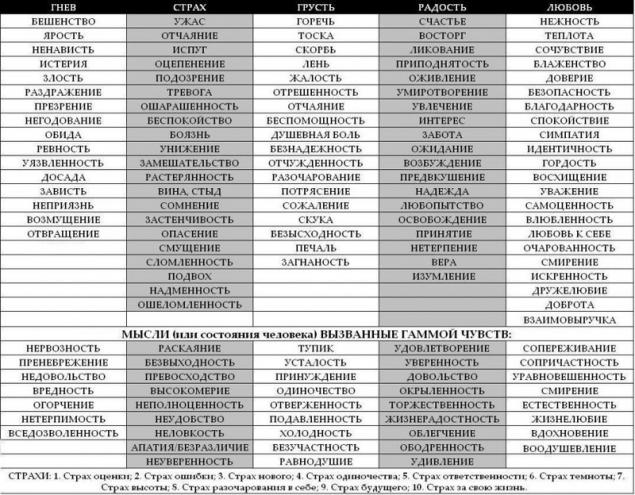
And for those who read the article to the end. The purpose of this article is to help sort out their feelings, what they are. Our feelings are largely dependent on our thoughts. Irrational thinking often underlies negative emotions. Correcting these errors (after working on thinking) we can be happier and achieve more in life. It will be an interesting, but hard and painstaking work. Are you ready?
Emotions, the existence of which we're NOT aware ofWomen's anger — lack of love
Source: timepost.ru/kakie-byvayut-chuvstva-i-ot-chego-oni-zavisyat.html

Wheel of emotions Robert Plutchik
What are the feelings? The simplest definition: feelings are what we feel. It is our attitude to certain things (objects). There is a more scientific definition: feelings (secondary emotions) — a special mental state, which manifests itself socially determined experiences that Express a long and emotional relationship of man to things.
Than feelings differ from emotions to Feelings — it is our experiences that we experience through the senses and we have five of them. Sensations are visual, auditory, tactile, gustatory and sense of smell (our sense of smell). With feelings it's simple: stimulus — receptor — feeling.
In emotions and feelings interfere with our consciousness — our thoughts, attitudes, our thinking. Emotions affect our thoughts. And conversely, emotions affect our thoughts. About these relationships, let's talk more definitely later. But now let us remember once again one of the criteria of psychological health, namely paragraph 10: we are responsible for your feelings, it depends on us what they will be. This is important.
Fundamental emotion of All human emotions can be distinguished by the quality of the experience. Most vividly this aspect of the emotional life of a person is represented in the theory of differential emotions American psychologist K.'d. He identified ten qualitatively different fundamental emotions: interest-excitement, joy, surprise, grief, suffering, anger-rage, disgust-revulsion, contempt-scorn, fear-terror, shame-shyness, guilt-repentance. The first three emotions K. Izard relate to positive, the other seven to the negative. Each of the fundamental emotions is the basis of a spectrum of conditions with differing degrees of severity. For example, in such odnomomentnoe emotions like joy, you can highlight the joy, the satisfaction, the joy, the delight, the glee, the joy, the ecstasy, and others. From the connection of fundamental emotions emerge and all the other, more complex emotional States. For example, anxiety can combine fear, anger, guilt, and interest.
1. Interest is a positive emotional state, contributing to the development of skills, acquisition of knowledge. Interest-excitement is the feeling of zahvachennoi, curiosity.
2. Joy is a positive emotion that is associated with the ability adequately to meet the current demand, the likelihood of that was small or uncertain. Joy is accompanied by the satisfaction and satisfaction of environment. Obstacles to self-realization are obstacles for the emergence of joy.
3. Surprise — do not have explicit positive or negative sign of the emotional reaction to sudden circumstances. Surprise hinders all of the previous emotions, directing attention to a new object and can be passed on in interest.
4. Suffering (grief) is the most common negative emotional state associated with obtaining accurate (or seemingly so) information about the impossibility of meeting the critical needs, the achievement of which seemed more or less probable. The suffering has the character of asthenic emotions and often takes the form of emotional stress. The most severe form of suffering, Woe associated with irrevocable loss.
5. Anger — a strong negative emotional state occurring most often in the form of passion; it occurs in response to the obstacle in achieving the desired goals passionately. Anger is the nature of scenicheskoe emotions.
6. Disgust is a negative emotional state caused by the objects (items, people, circumstances), contact with whom (physical or communicative) comes into sharp conflict with the aesthetic, moral or ideological principles and attitudes of the subject. Disgust, if it is combined with anger, can in interpersonal relationships motivate aggressive behavior. Disgust, like anger, can be directed to myself, lowering self esteem and causing self-deprecation.
7. Contempt is a negative emotional state that occurs in interpersonal relationships and caused by misalignment of attitudes, beliefs and behavior of entity object with those feelings. The latter are presented to the subject as low, fail to meet the standards and ethical criteria. Man is hostile to someone he despises.
8. Fear — a negative emotional state that appears when the actor receives information about the possible damage to his life well-being, about the real or imagined danger. In contrast to the suffering caused by direct blocking of vital needs, the person experiencing the emotion of fear, has only a probabilistic forecast of possible problems and acts on the basis of the forecast (often not credible or exaggerated). The emotion of fear can be astenicheskiy and asthenic character and occur either in the form of stress, either in the form of sustained mood of depression and anxiety, either in the form of passion (the horror).
9. Shame is a negative emotional state, reflected in the realization of the discrepancy between their own thoughts, actions and appearance not only to the expectations of others but also their own perceptions of appropriate behavior and appearance.
10. Wine — a negative emotional state, reflected in the awareness of their own nefarious actions, thoughts or feelings expressed in regret and repentance.
Table of feelings and emotions of a person And I want to show you a collection of feelings, emotional States that one experiences in their lifetime — generalized table that does not pretend to be scientific, but it will help you to understand yourself better. Table taken from a "Community dependent and codependent", the author — Mikhail.
All the feelings and emotions of man can be divided into four types. It's fear, anger, sadness and joy. What type of a feeling can be read from the table.
- Anger
- Anger
- Outrage
- Hatred
- Resentment
- Anger is
- A shame
- Irritation
- Revenge
- An insult
- Militancy
- Rebellion
- Resistance
- Envy
- Arrogance
- Disobedience
- Contempt
- Disgust
- Depression
- Stung by the
- Suspicion
- Cynicism
- Alertness
- Concern
- Anxiety
- Fear
- Nervousness
- Awe
- Concern
- Fright
- Anxiety
- The excitement
- Stress
- Fear
- Horror
- Exposure to obsession
- The feeling of threat
- Osalemisest
- Fear
- Depression
- The feeling of being trapped
- Confusion
- Perplexity
- Disorientation
- Incoherence
- Sense of the trap
- Loneliness
- Isolation
- Sadness
- Sadness
- Mount
- Depression
- Gloom
- Despair
- Depression
- Emptiness
- Helplessness
- Weakness
- Vulnerability
- Gloom
- The seriousness
- Depression
- Disappointment
- Pain
- Retardation
- Shyness
- Sense of lack of love for you
- Abandonment issues
- Pain
- Unsociable
- Dejected
- Fatigue
- Stupidity
- Apathy
- Complacency
- Boredom
- Exhaustion
- Disorder
- Fatigue
- Strife
- Impatience
- Temper
- Longing
- The Blues
- Shame
- Wine
- Humiliation
- Disadvantage
- Embarrassment
- Inconvenience
- The severity
- Sorry
- The pangs of conscience
- Reflection
- Grief
- Alienation
- Awkward
- Surprise
- Shock
- Lose
- Stupor
- Amazement
- Shock
- Susceptibility
- A strong desire
- Enthusiasm
- Emotion
- Anxiety
- Passion
- Insanity
- Euphoria
- Awe
- The spirit of competition
- Confidence
- Determination
- Confidence
- Audacity
- Readiness
- Optimism
- Satisfaction
- Pride
- Sentimentality
- Happiness
- Joy
- Bliss
- Fun
- The rapture
- Triumph
- Luck
- Fun
- Harmlessness
- Daydreaming
- Charm
- Valuation appreciated
- Appreciation
- Hope
- Interest
- Passion
- Interest
- Liveliness
- Liveliness
- Calm
- Satisfaction
- Relief
- The peacefulness
- Relaxation
- Contentment
- Comfort
- Restraint
- Susceptibility
- Forgiveness
- Love
- Serenity
- Location
- Adoration
- The rapture
- Awe
- Love
- Attachment
- Security
- Respect
- Friendliness
- Sympathy
- Sympathy
- Tenderness
- Generosity
- Spirituality
- Puzzlement
- Confusion

And for those who read the article to the end. The purpose of this article is to help sort out their feelings, what they are. Our feelings are largely dependent on our thoughts. Irrational thinking often underlies negative emotions. Correcting these errors (after working on thinking) we can be happier and achieve more in life. It will be an interesting, but hard and painstaking work. Are you ready?
Emotions, the existence of which we're NOT aware ofWomen's anger — lack of love
Source: timepost.ru/kakie-byvayut-chuvstva-i-ot-chego-oni-zavisyat.html






